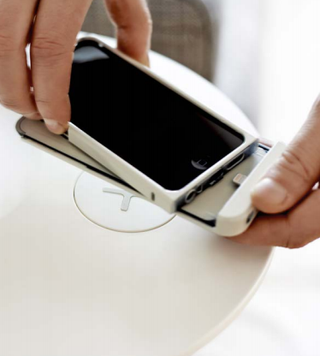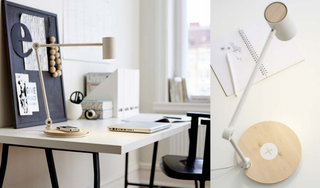IKEA's Qi-Powered Wireless Charging Furniture To Arrive In The U.S. 'Late Spring'

Back in March, IKEA announced that it's going to add Qi chargers into some of its furniture. Today, the company released an update containing information about its plan to bring this type of charger to market. IKEA's new furniture and wireless chargers will be sold in the U.S. "late spring" with the stand-alone wireless chargers starting at $28.

The cheapest available options will be some charging pads that you can use on top of your existing furniture that will go for $28 to $65. The $28 charging pad can charge two devices at once, while the $65 model can charge up to four smartphones.
You will also be able to order a Jyssen wireless charger for $30, and for $5 more IKEA will also give you a special drilling accessory to cut a matching slot in any piece of furniture you want.

Some of the new flagship smartphones come with Qi charging support, but the vast majority of smartphones on the market do not. IKEA will also sell charging cases for iPhone (4, 5, 5s, and 6) and Galaxy (S3, S4 and S5) phones for $15 to $25.

In terms of furniture that comes with built-in wireless chargers, IKEA will sell two bedroom nightstands for $60 and $110, and three lamps that will cost $70, $80 and $120 each.
There's still a battle of wireless charging standards happening right now, with a winner that has yet to be decided. Last year, Starbucks announced that it will use Powermat (a Qi competitor) charging spots in its stores, which already gives the Powermat's PMA technology a big head-start in the U.S. However, McDonalds has also started to test Qi chargers in its stores in Europe, giving IKEA an even bigger ally in the fight between the wireless charging standards, if McDonalds decides to stick with it.
As if that wasn't enough, Ossia has also come out with yet another technology that promises long range wireless charging. However, that could end up serving a different type of market, one where products can't be easily put on top of a charger on a tablet, the way it works with smartphones.
Stay on the Cutting Edge
Join the experts who read Tom's Hardware for the inside track on enthusiast PC tech news — and have for over 25 years. We'll send breaking news and in-depth reviews of CPUs, GPUs, AI, maker hardware and more straight to your inbox.
Samsung, the world's largest smartphone maker, has given up on trying to decide which charging technology will be the winner (at least for now) and is supporting both the Qi and PMA standards in the Galaxy S6. Perhaps in the short term this will end up being the best solution for OEMs to make sure their devices can charge wirelessly everywhere until companies such as IKEA, Starbucks and McDonalds all start backing a single standard.
Follow us @tomshardware, on Facebook and on Google+.

VESA introduces DisplayPort 2.1a standard, providing higher resolution and refresh rate combos and doubling cable length limit

Nvidia's problems with melting GPU connectors intensify — CableMod issues safety recall of 16-pin power adapters for Nvidia GPUs due to overheating and melting, advises disconnecting them immediately
-
Calvin Huang That's pretty brilliant actually. Having the charger inlaid within the desk/appliance makes it much more usable and hides the bulk of the charger (the Jyssen charging pads are actually about the same size as most standalone Qi disks, but the exposed circular cutout is only half the diameter of the actual charging pad.Reply -
Engerek01 With the amount of electro magnetic induction this may cause some series long term problems. What will be the range of that magnetic wave? What is the frequency? I hope they took precautions to avoid any damage in cell level.Reply
Other than that it is an amazing technology. It would sort out the "do you have free plug" questions and the cable mass in starbucks. -
joex444 @Engerek01, please don't comment if you haven't taken college level calculus-based physics courses. The strength of a magnetic (or electric) field goes like 1/r^2. To make an example, suppose the field has strength X at 1cm - a reasonable distance for the gap between the charger and phone/device. If you stand 0.5m away (about 1.5 ft), the strength is 50^2 smaller. Or 2500 times smaller. If you're a meter away it's 100^2 or 10,000 times smaller.Reply -
David Cruit Reply@Engerek01, please don't comment if you haven't taken college level calculus-based physics courses. The strength of a magnetic (or electric) field goes like 1/r^2. To make an example, suppose the field has strength X at 1cm - a reasonable distance for the gap between the charger and phone/device. If you stand 0.5m away (about 1.5 ft), the strength is 50^2 smaller. Or 2500 times smaller. If you're a meter away it's 100^2 or 10,000 times smaller.
That's more High School basic Physics. Just covered it.
-
Engerek01 Reply@Engerek01, please don't comment if you haven't taken college level calculus-based physics courses. The strength of a magnetic (or electric) field goes like 1/r^2. To make an example, suppose the field has strength X at 1cm - a reasonable distance for the gap between the charger and phone/device. If you stand 0.5m away (about 1.5 ft), the strength is 50^2 smaller. Or 2500 times smaller. If you're a meter away it's 100^2 or 10,000 times smaller.
I am a Mechanical Engineer with masters degree. What you are saying is true on paper. What you dont know is that, if even a phones microwave is strong enough to make an airplane crash, I cant start to imagine what this can do to a person in a cell level. Read articles about how cell phones increased brain tumor and cancer density in the last 10 years. Then you will start to understand the tragedy this may cause.
-
Engerek01 @joex,Reply
And I was dealing with electro-magnetic fields when i was 12. I am 36 years old now. -
Engerek01 I want to add something. In 2001, we asked our professor if base stations could do any harm to human body. He laughed at us and said "Even a tv power cable has stronger magnetic field." 3 years later he and his wife became cancer. He died 1 year after that. He spent that remaining 1 year explaining people how cell phones and base stations could cause cancer. You may think that 1/10.000 isnt strong enough to cause you any harm. But remember that water doesnt crack stone because of its strength but because of its persistence.Reply
Most Popular



